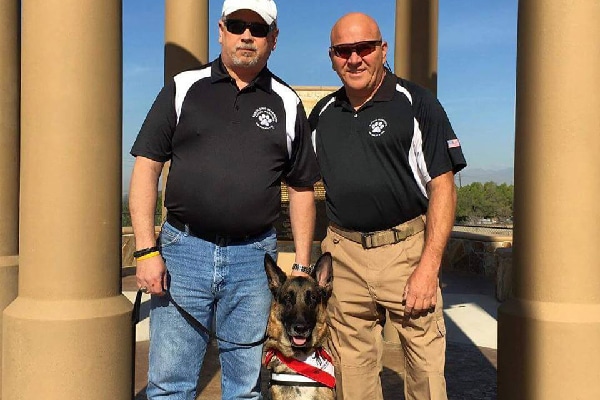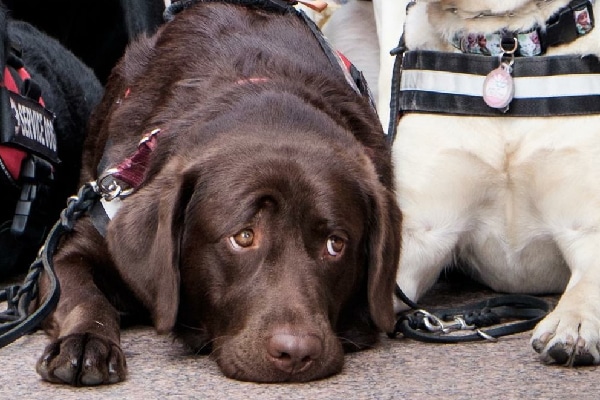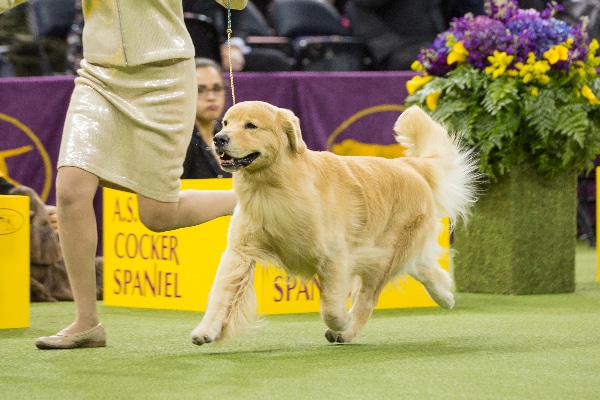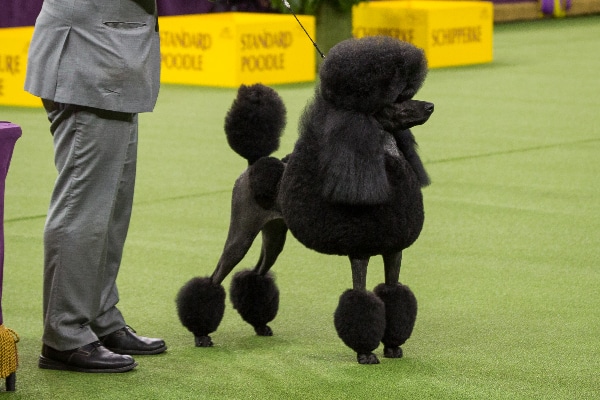The post Let’s Meet Some of the Best Service Dog Breeds by Lynn M. Hayner appeared first on Dogster. Copying over entire articles infringes on copyright laws. You may not be aware of it, but all of these articles were assigned, contracted and paid for, so they aren’t considered public domain. However, we appreciate that you like the article and would love it if you continued sharing just the first paragraph of an article, then linking out to the rest of the piece on Dogster.com.
The heroes of the canine kingdom, service dogs are taking on increasingly diverse roles. We have hearing dogs for the deaf, diabetic alert dogs, psychiatric service dogs, visual assistance dogs, seizure assistance dogs, and wheelchair assistance or brace/mobility support dogs, to name a few. Before we talk about service dog breeds, let’s define what a service dog is.
First, what is a service dog?
The Americans with Disabilities Act (ADA) defines a service dog as one specifically trained to perform tasks for a disabled individual who would otherwise have trouble completing those tasks. A service dog is expressly trained to assist with his human partner’s particular disabilities. While some mixed breeds are used for service, much work is performed by purebred dogs. Certain temperaments, traits and physiques make it easier for these dog breeds to learn and perform the tasks of a service dog. Let’s meet five top service dog breeds right here.
German Shepherd Dog

We can’t make a list of service dog breeds without including German Shepherd Dogs. Photography courtesy Deborah Stern and Rebuilding Warriors.
Of course, we lead the list for service dog breeds. We’ve been serving humanity in countless roles for over a century. We’re a highly-intelligent, loyal and hardworking breed, developed by Captain Max von Stephanitz in late 19th-century Germany. A popular breed for military and police work, we’re also frequently chosen for guide and hearing assistance work. Bred specifically to work with humans, we’re among the service dog breeds that are easily trained to perform many tasks.
Perhaps you’ve heard of our forefather, Buddy, a German Shepherd Dog trained by Dorothy Harrison Eustis in the Alps to lead the blind? Buddy came to the States to partner with Morris Frank, the first American to benefit from a Seeing Eye dog. As sight dogs, we’re trained to guide our handlers with both obedience and intelligent disobedience (ignoring commands that might endanger our handlers). In addition, we’re celebrated deterrents to criminals.
Labrador Retriever

Labrador Retrievers were bred for sport but they’re able to sit quietly too. Photography courtesy Black Dogs Rule and Deborah Stern.
Let’s talk first about energy. Preferably, service dog breeds fall mid-range on the energy spectrum: capable of extensive physical activity, but also ready to sit quietly. While we Labs were originally bred for sport, we were expected to relax with family, too. Our ancestors worked with fisherman off the Labrador Sea shores. Our lively forefathers were further developed in England for hunting and retrieving. Perceptive and good natured, we make outstanding service dogs, whether we’re guiding the vision-impaired or alerting a person with diabetes to sugar levels.
Now let us clarify a frequently asked question about service dogs and service dog breeds. A dog whose sole function is to provide emotional support does not qualify as a service animal. The ADA distinguishes between psychiatric service animals and emotional support animals. Here’s an example: A dog that provides comfort to an anxious individual is an emotional support dog. But if the dog has been trained to sense anxiety attacks and take specific actions to lessen the attack’s impact, he’d be a service animal.
Never fraudulently represent your dog as a service dog to take him places he isn’t allowed. This poses obstacles to the true service dogs. Service dogs are well trained and well mannered, far more than the typical dog at home, and have to pass tests to be certified. At least 19 states are now cracking down on pet parents who fraudulently pass off their dog as a service dog when he is not.
Golden Retriever

Golden Retrievers make great service dogs. Photography by Kayla Bertagnolli, as captured at the 2018 Westminster Kennel Club Dog Show.
Before we brag on our breed, let us mention that a large number of prospective service dogs don’t make the cut. While the consistency of traits (within each of these service dog breeds) offers a rather dependable prediction of outcome, all dogs are individuals. Some of us might lack the drive, physical abilities, bravery or stick-with-it personalities needed for service work.
Now, let’s talk Golden history and what lands us on this list of service dog breeds. We were developed in mid-19th-century Scotland as gun dogs for retrieving fowl. Lord Tweedmouth fine-tuned us for a delight in water work, as well as superior retrieving skills. Bred hardy for work, we were yet expected to have a gentle mouth and spirit. No birds to be retrieved? Our working skills and gentle nature transfer effectively to service work. And moreover, we’re a highly biddable breed. That’s code for: we love to learn and please our people.
Some of our service work requires harmonizing vigilance with calmness, strength with tenderness. We service Goldens also readily accept the presence of strangers. But you won’t likely see us wildly greeting new people. We mustn’t let new people or situations distract us from our important work.
Standard Poodle

Standard Poodles make the cut for popular service dog breeds. NOTE: service dogs would not typically be groomed like this. Photography by Kayla Bertagnolli, as captured at the 2018 Westminster Kennel Club Dog Show.
We may not be the first breed that comes to mind when thinking “service dog breeds.” But us Standard Poodles are a highly trainable, loyal and dependable breed. Our low-shedding coat is also a benefit for allergy sufferers. Developed first in Germany for water retrieving, we’re brainy and obedient, as well as suitably sized at about 45 to 70 pounds for service work.
Our innate curiosity and desire for mental stimulation facilitates our work and responsibilities. We’re eager and ready to problem solve as necessary. No service dog can be rehearsed for every situation that may occur; we need the resourcefulness and intelligence to generalize our training into new circumstances.
Pomeranian

Pomeranians are a small but mighty service dog breed. Photography by Kayla Bertagnolli, as captured at the 2018 Westminster Kennel Club Dog Show.
We’re another breed that you might not traditionally associate with “service dog breeds.” But we’re remarkably enthusiastic and bright small dogs, bred down from the bigger Spitz breeds in the Pomerania region. We’re pint sized, but we’re brave, sprightly and self-assured. Our small size may even come in handy. You may see us accompanying our owners in stores, restaurants or appointments. Some of us may be emotional support dogs, but others of us are service dogs (as defined by the ADA, and nicely explained by the Labrador above).
Of course, with our height and weight, we’re not expected to physically assist individuals with mobility challenges or guide the sight-impaired. But we may assist an individual with psychiatric conditions such as PTSD, or other indivisible disabilities such as autism, diabetes and epilepsy.
Now, remember, that we working Poms may elicit more disapproving looks in stores and restaurants than other (notably bigger) service dogs. Many people suspect our handlers are simply putting vests on us to sneak us indoors. But invisible disabilities are as real as visible ones. While our size is small, our work is extremely important.
A final word on service dog breeds and service dogs
Looking for general info on service dogs? Check out the International Association of Assistance Dog Partners. Interested in the specific canine program (featured in our photos) that helps our veterans? Check out Rebuilding Warriors.
Thumbnail: Photography courtesy Deborah Stern.
Why read breed profiles?
Dog breed profiles help everyone, whether you have a mixed breed or purebred dog, to better understand and improve the quality of your dog’s life. If you have a mixed breed dog, read up on all of the breed profiles that make up your dog. Not sure what breed your dog is? There are a number of easy DNA tests out there to help your find out.
This piece was originally published in 2018.
Read more about dog breeds on Dogster.com:
The post Let’s Meet Some of the Best Service Dog Breeds by Lynn M. Hayner appeared first on Dogster. Copying over entire articles infringes on copyright laws. You may not be aware of it, but all of these articles were assigned, contracted and paid for, so they aren’t considered public domain. However, we appreciate that you like the article and would love it if you continued sharing just the first paragraph of an article, then linking out to the rest of the piece on Dogster.com.
No comments:
Post a Comment